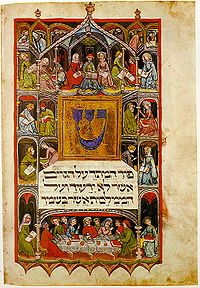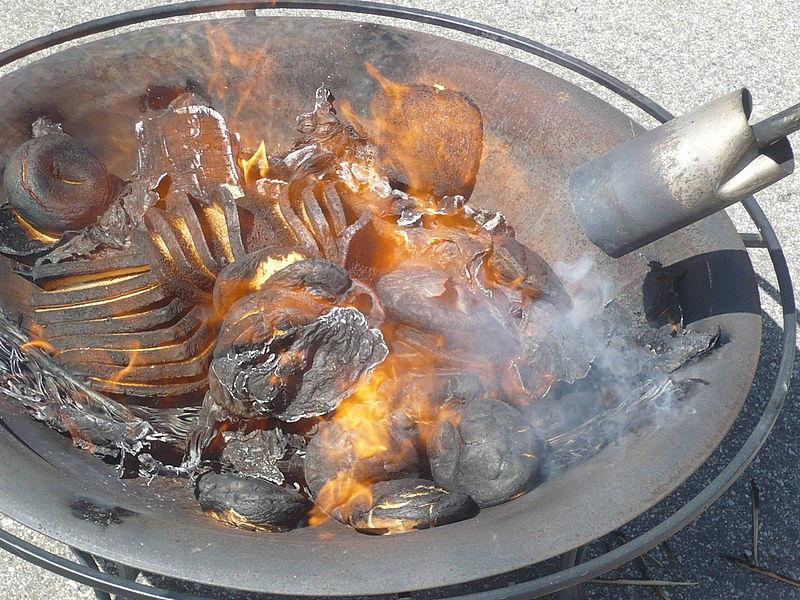The Passover Haggadah
Columbia version.

The Haggadah (or telling) of Passover the oldest continuously celebrated festival in all of history. The reading of the Haggadah is based on Exodus 13:8, "You shall tell your son on that day: it is because of what the Lord did for me when I came forth out of Egypt."
There are over 2000 different versions of the Haggadah, so the first question to ask is, why do we need another one? The editor wanted to link the story of the Last Supper and the Haggadah into a single comprehensive and concise document. Although it would be a fantasy to assume that Jesus and His Disciples celebrated in the manner given here, it might enable us to experience the Jewish Passover in a manner which also remembers the Last Supper and calls to mind what Jesus and His Disciples might have done.
Additional Reference material, which is not a part of the story, is provided by links in the text. Such links are underlined and in blue (like this.) Clicking on a link will take you to the additional material, without losing your place in the story. Such additional material is for explanation, and is not necessary as part of the telling of the Passover, but it might be good if one were at least familiar with the explanatory material.
I am not the author, just the editor. I created none of this, but targummed (or translated into the common language) what I have read and experienced. As source material I used more than 20 versions of the Haggadah, the King James Version of the Bible, and the traditions as experienced in Passover celebrations at the Community on Columbia, a ministry started by Trinity Foundation, Inc.
It is important that this not be a liturgy with a leader droning through the text. Every person should see himself as if he were brought out of Egypt and discuss what that means to him. Every question should be asked and every question answered.
Copyright © 2013. You may distribute the entire document as you wish. You may charge a fee, but no more than the cost of media and shipping. If you find this work of value and wish to, you can use this link to send a contribution or donation.
Before Passover
Blessing before the search: Blessed art Thou, O Lord our God, King of the Universe, who made us holy by His commandments and commanded us to purify our premises of all leaven.
Search out the leaven in your house and in you, as you choose.
Blessing after the search: All leaven upon my premises, which I have not seen or removed, which I have not been aware of, shall be declared null and void as the dust of the earth.

Burning of Leaven
Blessing after the leaven is burned: All leaven upon my premises, whether I have seen it or not, whether I have removed it or not, shall be declared null and void as the dust of the earth.
Fast of the Firstborn
All who can should fast starting at sundown on the night before the Passover, to increase hunger for the matzah. If you have been born again, then you are first born, even if you weren't the first child in your family.
Preparation of the Seder

Luke 22:7-14 "Then came the day of unleavened bread, when the passover must be killed. And he sent Peter and John, saying, Go and prepare us the passover, that we may eat. And they said unto him, Where wilt thou that we prepare? And he said unto them, Behold, when ye are entered into the city, there shall a man meet you, bearing a pitcher of water; follow him into the house where he entereth in. And ye shall say unto the goodman of the house, The Master saith unto thee, Where is the guestchamber, where I shall eat the passover with my disciples? And he shall shew you a large upper room furnished: there make ready. And they went, and found as he had said unto them: and they made ready the passover. And when the hour was come, he sat down, and the twelve apostles with him."
In Israel, most homes were built with an upper room which was reserved for Passover and perhaps other feasts and special events. Accordingly, the setting of the Passover should be as special and festive as possible. One tradition holds with draping the room in white and all participants wearing white, representing the righteousness of Christ.
Jesus' disciples sat in age order, with the oldest (Judas) on Jesus' left and the youngest (John) on his right. Before chairs, everyone sat on the floor, on pillows and reclining to the left. While you may not choose to do this, it makes some verses clearer. For example John 13:23, "Now there was leaning on Jesus' bosom one of his disciples, whom Jesus loved", is clearer if you understand that John was leaning on Jesus' bosom was because of the way they were reclining at the Passover table.
Several items are present in front of the seder leader and may be present at intervals around the table.
First are three matzahs [sheets of unleavened bread] covered with a white linen cloth.
Second is a large plate or tray with seven items on it as follows:
- Z'roa, the roasted shank bone of a lamb or goat; symbolizing the Passover sacrifice, which was a lamb that was offered in the Temple in Jerusalem, then roasted and eaten as part of the meal on Seder night. Z'roa also means "right hand" or "right arm."
Psalms 98:1 "O sing unto the LORD a new song; for he hath done marvelous things: his right hand, and his holy arm, hath gotten him the victory."
John 1:29 "The next day John seeth Jesus coming unto him, and saith, Behold the Lamb of God, which taketh away the sin of the world."

- Beitzah, a hard-boiled egg, symbolizing the festival sacrifice that was offered in the Temple in Jerusalem and roasted and eaten as part of the meal on Seder night. The egg, a symbol of mourning (as eggs are the first thing served to mourners after a funeral), evokes the idea of mourning over the destruction of the Temple and our inability to offer any kind of sacrifices in honor of the Passover holiday.
The egg can also represent the New Jerusalem, in part because there is no door, therefore no way in except that God would make it possible. The egg could also represent the spirit of God which is shed on all flesh. Acts 2:16-17 "But this is that which was spoken by the prophet Joel; And it shall come to pass in the last days, saith God, I will pour out of my Spirit upon all flesh."
The above two items are also proof that this was not the way Jesus would have celebrated the Passover with His disciples. The temple was still standing and the Passover sacrifices were still made, so there was no reason to have the above two items as remembrances.
- Maror, a bitter herb, symbolizing the bitterness and harshness of the slavery which the Hebrews endured in Egypt. Either horseradish or romaine lettuce may be eaten in fulfillment of the mitzvah of eating bitter herbs during the Seder. The word "maror" comes from the Hebrew word mar, "bitter."
Exodus 15:23 "And when they came to Marah, they could not drink of the waters of Marah, for they were bitter: therefore the name of it was called Marah."
Ruth 1:20 "And she said unto them, Call me not Naomi, call me Mara: for the Almighty hath dealt very bitterly with me."
- Haroseth, a sweet, brown mixture representing the mortar used by the Jewish slaves to build the storehouses of Egypt. The word "haroset" comes from the Hebrew word cheres, "clay."
- Karpas, a vegetable other than bitter herbs, which is dipped into salt water at the beginning of the Seder. Parsley, celery or boiled potato is usually used. The dipping of a simple vegetable into salt water (which represents tears) mirrors the pain felt by the Hebrew slaves in Egypt.
- Hazeret, another bitter herb, either romaine lettuce or horseradish, eaten in a sandwich later in the seder.
- Salt water, representing the tears shed by slaves in Egypt and used to dip the karpas in.
Finally, each guest should have a Haggadah, or perhaps just the portions relevant to the Seder meal itself.
After Passover
Passover Homily of Melito, Bishop of Sardis
A Medical Description of the Crucifixion
Song of Songs
It Came to Pass at Midnight
A Feast of Passover
For Him it is Seemly, for Him it is Meet
Additional Reference Material
Passover in Egypt (Exodus 12:1-27):
Hezekiah's Passover (2 Chronicles 29:1-32:32) ~715 BC:
Josiah's Passover (2 Kings 22:8-23:23, Chronicles 34:15-35:18) ~633 BC:
Ezra's Passover (Ezra 6:1-22) ~457 BC:
Jesus' Passover (Matthew 26:17-30,
Mark 14:12-26,
Luke 22:7-39,
John 13:1-18:1)
Haim the Porter
Grandfather's Story
The Plagues and their Meaning
Let's Make a Deal
History of the Haggadah



